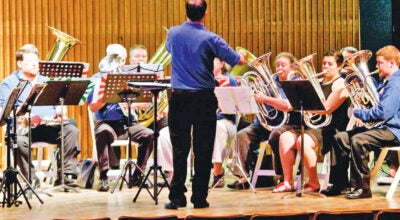The Jenny Wiley Experience
Published 12:00 am Sunday, March 7, 2010
PRESTONBURG — Ty Lindon has a dream job. Maybe it’s best when he puts it in his own words, describing his workdays.
“I like to hike and breathe the early morning fresh mountain air and see the sunlight hit the tops of the mountains as I’m walking the trails. In early spring, I’m able to hear a turkey gobble or listen to Pileated Woodpecker. Hear a King Fisher on the lakeshore trail,” the Jenny Wiley State Resort Park manager went on.
“On rare occasions, I’ve had the opportunity to view elk, Black Bear and an American Bald Eagle at the park. I enjoy listening to the turkeys chirp between themselves. I believe they are communicating about me,” he joked.
He’s hiked the Jenny Wiley Trail, summiting the Tecumseh Overlook for a glimpse of the rocky mountaintops. He’s eavesdropped on barking coyotes and canoed down John’s Creek to catch glimpse of a beaver lodge.
All in a day’s work…
Since August 2005, Lindon has viewed the vistas of the Jenny Wiley backdrop he calls home. He is forevermore thankful for its natural beauty and encourages visitors to share in the wonder.
“It’s an ideal place to work or an excellent place to getaway for a few days or even a week’s vacation.”
That’s because, for vacationers, it’s a one-stop shop with lots to do — camping, hiking, biking, or swimming.
It’s a place to escape the hustle and bustle, a retreat from the grind. Nestled in the eastern Kentucky hillsides, the park is surrounded by towering pines and hardwoods, peaceful and perfect.
“Hiking the trails, pontoon boat rides, fishing from the banks, playing golf on our nine-hole course, reading a book on a cottage porch. It’s relaxing,” Lindon went on. “I feel like the park has something to offer stressed-out travelers or a person who just wants to getaway for a day or two.”
To cure the blahs, travelers can settle in for comfort foods like Kentucky Hot Brown — warm and crunchy toast points with baked country ham and roasted turkey, smothered in cheese sauce and topped with tomato, bacon and cheddar cheese.
Or, there’s farmhouse fare like pinto beans; a mild catfish fillet rolled in seasoned meal and fried to a golden brown, or a center cut of country ham with red-eye gravy.
Lindon finishes it off with homemade steaming banana pudding.
When visiting, it’s all about the quiet pleasures in life, embracing the rich eastern Kentucky history and culture, derived from Jenny Wiley’s community neighbors of Prestonsburg; Pikeville; Paintsville; Auxier; Martin; May Town, and Allen.
It brings Lindon great joy, seeing customers come back for more, chatting about family amusements and leisure, recollections of R and R.
“You get to know people. They get to know you and you develop a special relationship,” he concluded. “The staff at the park wants all our customers to build positive memories about all their visits to Jenny Wiley.”
Jenny Wiley demonstrated bravery in face of fear
Jenny Wiley State Resort Park Manager Ty Lindon endeavors to help visitors understand the significance of the park’s namesake to Kentucky history – offering up the intrepid woman’s story of pluck and boldness while held prisoner by Indians.
Early pioneers like Virginia (Jenny) Sellards and her husband, Tom Wiley needed courage and endurance to battle both nature and native Indians while trying to make a homestead in a new land.
In reality, the capture of Jenny and the destruction of the Wiley family was entirely in error. Sometime before, a member of the neighboring Harmon family shot and killed several Indians.
It was a dark and rainy Oct. 1, 1789, in Ab’s Valley, VA (Walker’s Creek), when a band of Indians returned to seek vengeance. Not knowing the exact location of the Harmon cabin, the Indians fell upon the Wiley family instead. Jenny’s husband, Tom was away when Indians surprised the family and killed three of Jenny’s children and her younger brother.
Jenny – then pregnant, and her 15-month-old son were taken captive. Friends and family searched to no avail.
The Indians traveled west. When Jenny couldn’t keep up while carrying her infant son, he was killed. Months passed and Jenny began to adapt to life with the Indians. She gave birth to another son, but he was killed after failing an Indian test of courage. He cried out when tied to a piece of wood and slipped into a stream.
Sentenced to die, Jenny was bought by a Cherokee chief who was impressed with her courage. She performed chores and taught the other women to make cloth.
One night, after eleven months of captivity, Jenny staged her escape. Amazingly, she found her way to the John’s Creek settlement, known as Harmon’s Station. Within several weeks, she was reunited with her husband.
The couple began rebuilding their life together and had five more children and moved to the Big Sandy valley in 1800. Tom died in 1810, but Jenny lived until 1831, dying of paralysis at 71.
Both are buried in the Big Sandy area. Jenny’s grave is located in River, in nearby Johnson County.




